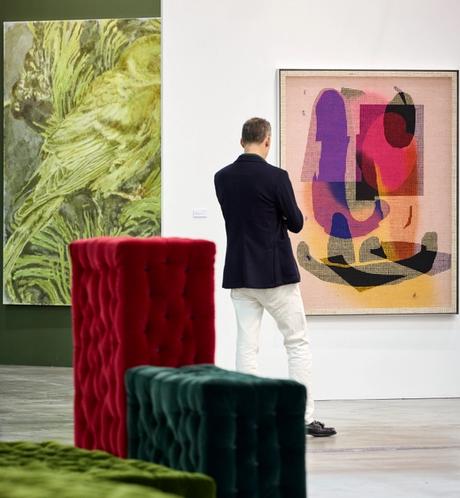The 31st edition of Artissma in Turin (until 3 November), Italy’s oldest contemporary art fair, takes place amid a high stakes moment for the country’s art trade. A forthcoming decision on tax rates for art could have sizable effects on the 87 Italian commercial galleries showing at the fair this year, and potentially boost the country’s promising but stymied art market.
Despite Italy’s considerable number of private foundations and other philanthropic organisations to support contemporary art—especially in the rich, industrialised north—high sales taxes and strict laws to regulate the trade of cultural goods continue to impede the trade. France’s share of the global art market is around six times larger, according to data published by UBS/Art Basel.
Change could come soon: Italian lawmakers must decide by the end of this year on a proposition to lower taxes on art, prompted by a new EU regulation to simplify VAT structures by 1 January 2025. This could see VAT on primary market sales and also on art imported from outside the EU drop from 10% to 5.5%. Meanwhile, VAT on secondary market sales could also be lowered, from 22% to between 10% to 5%.
“The new regulations could have a transformative effect. We are waiting in hope,” says Luigi Fassi, Artissima’s director since 2022. Fassi’s words are echoed by many Italian dealers at the fair, such as Maria Giulla Rocco, a Naples-based director at Thomas Dane. The gallery’s stand includes a wall sculpture by Lynda Benglis, a large photograph of a basketball player by Paul Pfeiffer and sculptures by Jean-Luc Moulène. As Rocco stresses, a decision is still to be made despite the looming deadline: “We take our time in Italy.”
Top reported sales among the Italian galleries at the fair include a Maggi Hambling work, sold for €50,000 by Thomas Brambilla from Naples. And Repetto from Lugano sold works by Arte Povera artists to “various Italian collectors”, for between €60,000 to €150,000. These included a 1983 iron and wood sculpture by Jannis Kounellis, a 1979 plaster and brass piece by Fausto Melotti and a 1982 mixed media work by Mario Merz, whose birth centenary is being celebrated at Turin’s Fondazione Merz with the exhibition Something that removes the weight that maintains the absurdity and lightness of the fable (until 2 February 2025).
Adding to the anticipation of the tax proposal are key changes to government leadership. According to the Italian adviser Mattia Ponzi, the lowering of VAT on art was being championed by Vittorio Sgarbi, the former junior culture minister who stepped down in February over allegations that he laundered stolen art. “He was instrumental in fighting to get this proposition passed,” Ponzi says. “Without him, things are less clear.”
Pressingly, should the proposition be rejected and tax rates remain as they are, Italy’s position in the European art trade could be imperilled. This is because neighbouring France and Germany will enjoy much more favourable VAT rates come 2025: France secured the future of its already advantageous 5.5% VAT rates in 2023, while in June, Germany’s parliament voted to slash its VAT on art sales from 19% to 7%, widening the gap between Italy and its neighbours to the north.
This concern was raised in a paper published in June by the Apollo Group, a working group of leading auction houses, advisers and galleries across Italy that is lobbying the government to help the art market. If Italy does not secure the new VAT rate, “any collector who wanted to import or buy a work in the European Union would certainly not do so in Italy,” it states.
Such sentiments are echoed by Paola Potena, a director at Lia Rumma. “It will be a disaster if the proposition doesn’t pass. We will all have to pack up and move to Paris.” Lia Rumma, one of Italy’s largest galleries with locations in Milan and Naples, has “a programme that is extremely international and our presentation at Artissima always reflects that”, Potena says. This year at the fair, the gallery is showing artists like South African star William Kentridge, drawings by Wael Shawky, who is representing Egypt in the Venice Biennale.
It’s not just dealers hoping for a positive outcome. Turin’s eminent contemporary art collector Patrizia Sandretto Re Rebaudengo says her “fingers are crossed” for a lowered VAT on art. She adds that this is just one way she hopes the government will help the art industry. Another aspect she wants to change is the inclusion of private foundations with public facing roles, such as the one she runs, in the Art Bonus scheme—whereby companies sponsoring public art and heritage organisations receive a 65% tax rebate.
But there are some reasons for Italians to rejoice too. Thanks to appealing income taxes, the country has seen an influx of millionaires from overseas over the past few years. This phenomenon is expected to increase further due to the UK this week closing its tax loopholes for non-doms, which are residents whose permanent domicile is outside the UK for tax reasons.
“We’ve indeed observed a gradual shift among collectors away from the UK, a trend that began with Brexit and has since been accelerated by Italy’s appealing flat tax,” says Jose Graci, a director at Mazzoleni gallery, which has locations in London and Turin. At the fair, the gallery sold a 2024 paper collage by Marinella Senatore for between €15,000 to €20,000, among other works.
“The end of non-dom tax benefits in the UK has also contributed to this relocation trend, as Italy now provides a more stable tax landscape for overseas wealth,” Graci adds. “While the long-term impact of these tax changes is yet to be fully seen, it is clear that those who would have previously considered moving to the UK are now finding Italy as a more attractive option.”









